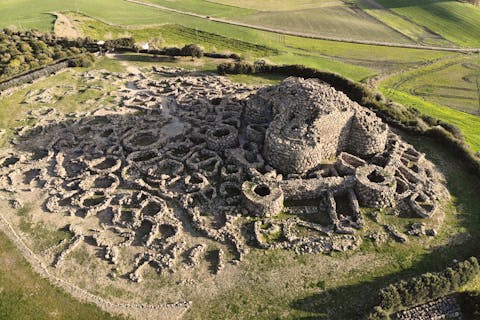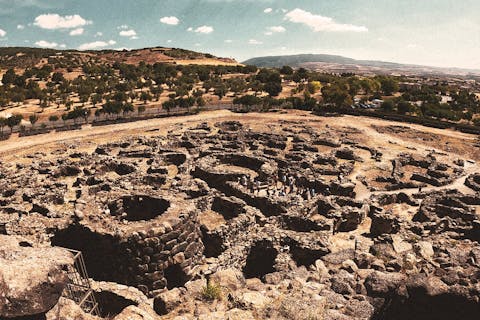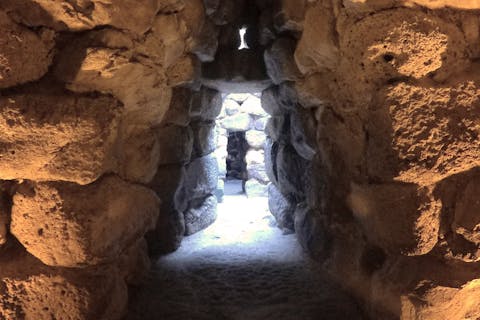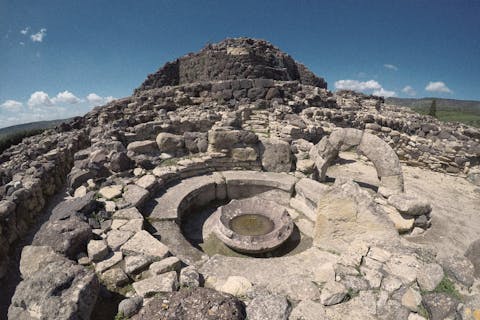Barumini Su Nuraxi Visit Information I Olianas

Art and culture
A visit to the archaeological site of Su Nuraxi di Barumini
The town of Barumini rises just 10 minutes from Tenuta Olianas, in the lush green plateau of the Mannu River valley. This is where the archaeological site of Su Nuraxi, Sardinia’s most important and best-preserved example of a Nuragic complex, lies. Visiting it is an extraordinary experience that allows one to dive deep into the island’s centuries-old culture.
Touring Barumini and its surroundings means embarking on an enlightening journey back in time to ancient pre-Roman Sardinia and discovering an incredible world rich in history and tradition. The area’s many diverse marvels allow visitors to enjoy a firsthand experience of the timeless, enveloping atmosphere brought on by the precious legacy left behind by the glorious Nuragic people.
Barumini owes its notoriety to the monumental complex of Su Nuraxi, located at the foot of the Parco della Giara. It is the most impressive, intact, and complete Nuragic archaeological site in the world, and Sardinia’s only UNESCO-listed archaeological area (inscribed in the World Heritage Site List in 1997).
Olianas is located in Località Purruddu (i.e. the Purruddu borough or neighborhood, one might say) along SP number 9. SP stands for Strada Provinciale, which translates as Provincial Road. Getting to the Nuragic village of Barumini is really easy from here: you can drive, or even ride a motorcycle or a bicycle. All you need to do is take the SP9 and head south for about 1.4 km until you find signs to Barumini. Follow the signs, enter SP5, travel on, and after 6.1 km you’ll be in Barumini. Once in town, just take the road called Viale Umberto I: you’ll soon be at the entrance of Sardinia’s most famous and remarkable archaeological complex.

The Su Nuraxi archeological site is open every day of the year, starting from 9:00 am.
Closing hours vary according to the season (and duration of daylight), as specified below:
- at 8:00 pm in May, June, July, and August
- at 5:00 pm in November, December, January, and February
- at 7:30 pm in April and September
- at 6:30 pm in October
- at 5:30 pm in March
Self-guided visits are not allowed: the authorized staff on-site is in charge of conducting the visits. Guided visits are regularly scheduled throughout the day and generally start every half hour.
Important: the last guided visit starts 1 hour before closing time.
Adults: €15 per person
Young adults (13 to 17): €12 per person
Children (7 to 12 years old): €9 per person
Babies and children up to 6 years old: free of charge
What your ticket includes
The above-listed entrance fees include access and guided tours of:
- Barumini archeological site
- The Casa Zapata Museum - the former residence of the Marquises of Aragona, a remarkable example of Spanish architecture, which now houses a museum comprising three different sections: archaeological, historical, and ethnographic.
- The Centro Giovanni Lilliu - named after Giovanni Lilliu, the archeologist who conducted the excavation campaign at the Su Nuraxi site. This is where the actual archeological site is located.
Duration of the tour: about 1 hour for each of the above sites
Please visit the Fondazione Barumini Sistema Cultura (Barumini Sistema Cultura Foundation) website for further information regarding group tours, reservations, and tour logistics in case of bad weather.

Much of the appeal of the Nuragic civilization lies in its mysteries. On the one hand, in fact, we have a population that played a leading role in the central Mediterranean trade routes for centuries. A thriving population, profoundly bound to the land, capable of the highest self-expression in architecture, crafts, and the arts. On the other hand, the total lack of written records (and hence the absence of indigenous historiography), has kept this civilization shrouded in shadows. To this day, archaeologists wonder whether the Nuragic people used a phonetic alphabet, or just relied on iconography and ideography, forms of expressions typical of prehistoric populations. Archaeologist Giovanni Ugas, however, maintains that the ancient Sardinians had already developed a complete alphabet in the Iron Age.
Su Nuraxi (14th-16th century BC) features a central tower, over 18 meters high, comprising three chambers placed one atop the other. This main building was initially built for sighting, defensive and religious purposes, and is surrounded by about 50 smaller circular buildings (mini nuraghi). These were constructed later than the central tower and up to the 6th century BC.
As mentioned above, Giovanni Lilliu was the one who unearthed and brought new life to the nuraghe of nuraghi - the Nuragic palace. As a result, Lilliu is currently considered the greatest Sardinian archaeologist of our century, and the "father of Sardinian archaeologists." Not surprisingly, the cultural center that stands a few steps away from the nuraghe is named after him, an important symbol of the Baruminese community’s ever-lasting gratitude. It's a unique setting, and often hosts events, concerts, and archeological and craftsmanship exhibits.
Wandering through the ancient ruins of Su Nuraxi is an incredible journey through millennia of history and culture: its massive basalt blocks seem to come alive and recount the fascinating story of their two-thousand-year-old life through their striking stratification. Walking among the smaller huts, wells, and water storage tanks that form the monumental complex, and discovering the ancient lifestyle, social roles, hierarchies, and fascinating construction techniques, one feels suddenly transported back in time.
One certainly cannot help admiring the grandeur of the central tower that towers over the ramparts from its 18.6 meters. It is indeed the distinctive symbol of the nuraghe, which literally means "pile of stones" and "cavity,". The Nuragic people’s name derives precisely from the word used to describe their distinctive defensive architecture.

Aiming to allow visitors to fully appreciate the centuries-old heritage of the Nuragic civilization, the municipality of Barumini chose to display the priceless artifacts found at Su Nuraxi at Casa Zapata, a majestic 17th-century Sardinian-Aragonese palace.
Whilst the former noble mansion was undergoing restoration to become a museum, Barumini's Nuragic heritage was enriched by another discovery: Su Nuraxi 'e Cresia, the thirty-first Nuragic site discovered in the area, lay right beneath the mansion itself!
This amazing coincidence led to the creation of the marvelous Casa Zapata Museum Complex. It is a unique combination of an unaltered 17th-century palace and an ancient archaeological site achieved thanks to the skillful use of suspended walkways and glass flooring.
The images on the page are courtesy of the Barumini Sistema Cultura Foundation.
